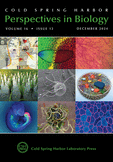Glycolysis
- Northwestern University, Feinberg School of Medicine, Chicago, Illinois 60611, USA
- Correspondence: Nav{at}northwestern.edu
This extract was created in the absence of an abstract.
Glycolysis is an ancient pathway that evolved well before oxygen was present in the Earth's atmosphere and is highly conserved among living organisms. Glycolysis was the first metabolic pathway elucidated and is also referred to as the Embden–Meyerhof–Parnas pathway (see Box 1). The word “glycolysis” is derived from the Greek “glykys,” meaning “sweet,” and “lysis,” which means “to split.” This refers to the splitting of one glucose molecule into two molecules of pyruvate, the end product of glycolysis. In the presence of oxygen, pyruvate usually enters the mitochondria where it is oxidized to acetyl-CoA, whereas in the absence of oxygen, pyruvate is reduced into lactate. Glycolysis involves 10 reactions that take place in the cytosol and generates two ATP molecules without the requirement of molecular oxygen. In contrast, oxidative phosphorylation in the mitochondria generates 30 ATP molecules but requires oxygen (see Chandel 2020a). Multiple simple sugars can enter glycolysis, including …




















